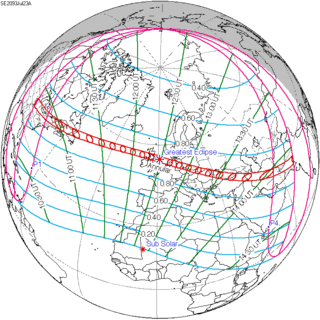| Solar eclipse of July 23, 2093 | |
|---|---|
| Type of eclipse | |
| Nature | Annular |
| Gamma | 0.5717 |
| Magnitude | 0.9463 |
| Maximum eclipse | |
| Duration | 311 s (5 min 11 s) |
| Coordinates | 54°36′N 1°18′E / 54.6°N 1.3°E |
| Max. width of band | 241 km (150 mi) |
| Times (UTC) | |
| Greatest eclipse | 12:32:04 |
| References | |
| Saros | 147 (27 of 80) |
| Catalog # (SE5000) | 9717 |
An annular solar eclipse will occur at the Moon's ascending node of orbit on Thursday, July 23, 2093,[1] with a magnitude of 0.9463. A solar eclipse occurs when the Moon passes between Earth and the Sun, thereby totally or partly obscuring the image of the Sun for a viewer on Earth. An annular solar eclipse occurs when the Moon's apparent diameter is smaller than the Sun's, blocking most of the Sun's light and causing the Sun to look like an annulus (ring). An annular eclipse appears as a partial eclipse over a region of the Earth thousands of kilometres wide. Occurring about 1.1 days after apogee (on July 22, 2093, at 10:10 UTC), the Moon's apparent diameter will be smaller.[2]
The path of annularity will be visible from parts of Illinois, Indiana, Ohio, Michigan, Pennsylvania, New York, Vermont, New Hampshire, and Maine in the United States, southeastern Canada, Ireland, the United Kingdom, the Netherlands, Germany, the Czech Republic, Poland, Slovakia, Hungary, Ukraine, Romania, Moldova, Turkey, Iraq, Iran, Pakistan, and western India. A partial solar eclipse will also be visible for parts of eastern North America, the Caribbean, Europe, North Africa, Central Asia, North Asia, and South Asia.
- ^ "July 23, 2093 Annular Solar Eclipse". timeanddate. Retrieved 24 August 2024.
- ^ "Moon Distances for London, United Kingdom, England". timeanddate. Retrieved 24 August 2024.
